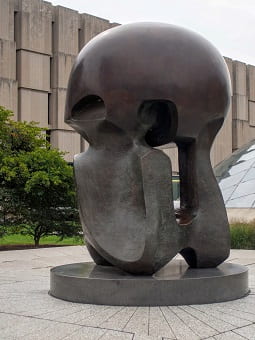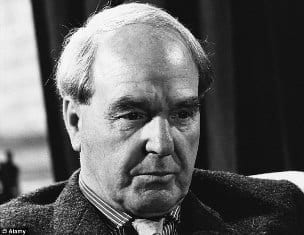Nuclear Energy
Henry Moore (1898–1986)

Created 1963-67
Installed 1967
Bronze
Height: 144 in (365.8 cm)
Located on Ellis Avenue between 56thand 57th Streets
Provided by the trustees of the B.F. Ferguson Monument Fund, 1967
“[Nuclear Energy] has a powerful capacity to keep the spectator in motion—drawing him around to the opposite side and, like many of Moore’s pieces, tempting one to crawl inside.”
David Katzive, “Henry Moore’s Nuclear Energy: The Genesis of a Monument”
On December 2, 1942, a team of scientists led by Italian émigré Enrico Fermi set the world’s first man-made, self-sustaining nuclear chain reaction in motion at Chicago Pile 1, the world’s first artificial nuclear reactor built under the original site of the University of Chicago’s Stagg Field. The event was a decisive step toward the creation of the age of atomic energy, and critically, at the time, to the production of the atomic bomb for use in World War II. Exactly twenty-five years later, on December 2, 1967, the sculpture Nuclear Energy was unveiled as a memorial to the accomplishments of Fermi and his fellow physicists.
The twelve-foot tall bronze sculpture was commissioned by the University of Chicago and created by British artist Henry Moore, one of the most preeminent public sculptors of his generation. Moore designed, modeled, and cast the sculpture between 1963 and 1967—in Moore’s mind, it was both a celebration of this incredible human achievement, and also a warning against the dangers of harnessing such natural, physical power. In a commentary on the work, he said:
Like anything that is powerful, it has a power for good and evil…the lower part [of the sculpture] is more architectural and in my mind has the kind of interior of a cathedral with sort of a hopefulness for mankind.
Sources
Burnell, H. “Sculpture of Atomic Birth Creates Stir at U. of C.”, Chicago Sun Times, September 26, 1965.
Haydon, H. “Henry Moore: An Appraisal”, University of Chicago Special Collections, Nuclear Energy Archive.
Katzive, D. “Henry Moore’s Nuclear Energy: The Genesis of a Monument”, Art Journal, 32.3, (Spring 1973), pp. 284-288.
McNeill, William H. Papers, Box 1, Folder 3, Special Collections Research Center, University of Chicago Library.
Archival Materials
Photograph of men polishing the bronze top during creation (side view)
Source: University of Chicago Photographic Archive, apf2-05338, Special Collections Research Center, University of Chicago Library
Photograph of the sculpture’s top being lifted onto the bottom for welding
Source: University of Chicago Photographic Archive, apf2-05339, Special Collections Research Center, University of Chicago Library.
Photograph of men polishing the bronze after welding (top view)
Source: University of Chicago Photographic Archive, apf2-05342, Special Collections Research Center, University of Chicago Library.
Photograph of Henry Moore with Nuclear Energy
Source: University of Chicago Photographic Archive, apf1-00916, Special Collections Research Center, University of Chicago Library.
Source: LUNA Library, UChicago Public Art Collection and Archive
Further Reading
Bach, I. & Gray, M. “A Guide to Chicago’s Public Sculptures”, 1983, University of Chicago Press.
Hedgecoe, J. “A Monumental Vision: The Sculpture of Henry Moore”, 1998, Stewart Tabori & Chang.

